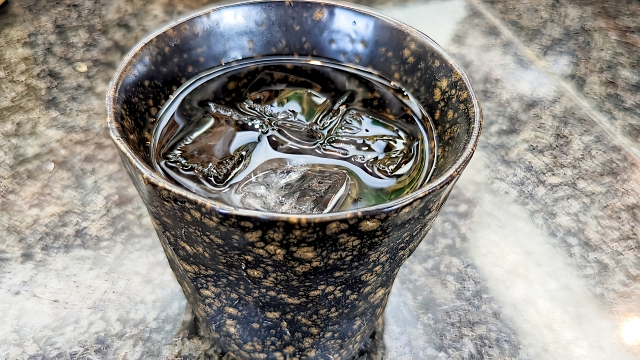
The History of Shochu – A Spirit Nurtured by the Passage of Time
The Legendary Beginning
The story of Japanese shochu is shrouded in a veil of deep and mystical history. According to ancient texts, shochu has been nurtured in the soils of Japan for centuries. However, the details of its origin are still a topic of much speculation. Some theories suggest that the technique came from China in the form of Awamori through Okinawa in the 14th century, possibly marking the first evolution of what is known today as “shochu.”
Shochu as a Regional Identity
Unraveling the history of shochu reveals the significant influence of each region’s culture and climate on the characteristics of the spirit. For example, Satsuma shochu from Kagoshima uses sweet potatoes born under volcanic soil and a warm climate, creating a rich and sweet flavor. In contrast, the colder climate of Hokkaido prefers wheat shochu with a crisp taste. Each region’s shochu reflects its climate, food culture, and the identity rooted in the lives of its people.
Shochu’s Evolution Across Eras
Over time, shochu has evolved from a daily beverage to a celebratory drink on special occasions. The post-war economic boom period particularly spurred the mass production and consumption of shochu. However, during this time, quantity was often prioritized over quality. This trend shifted in the 1990s with the authentic shochu boom, refocusing attention on quality. Traditional methods were revisited, and premium shochus using unique regional ingredients gained consumer support.
Distinct Characteristics of Regional Shochu
Shochu from different parts of Japan is deeply rooted in its respective local climates. In Kyushu, shochu is made from a variety of ingredients like rice, barley, and sweet potatoes, each producing its unique flavor. Satsuma shochu from Kagoshima expresses the sweetness and strength of sweet potatoes, Miyazaki shochu captures the fruitiness of potatoes, and rice shochu from Oita reflects the rich aroma of rice.
Shochu, more than just a beverage, is firmly rooted in the lives and hearts of the Japanese. Carefully crafted and aged over time, shochu embodies the spirit of each era and plays a role as a symbol of the region. This signifies the importance of Japan’s diverse climates and cultures in shaping the unique characteristics of regional shochu.
The Intersection of Tradition and Innovation
The history of shochu stands at the crossroads of tradition and innovation. While technological advancements have led to more refined distillation and aging techniques, many breweries still adhere to traditional methods. This is because shochu is perceived not just as an alcoholic drink but as a cultural heritage and an integral part of people’s daily lives. Shochu continues to thrive alongside Japan’s nature, enriching the hearts of its people.
Shochu in the Modern Era
Today, shochu is establishing itself as an international spirit, transcending regional boundaries. Interest in shochu, along with Japanese culture, is growing overseas, winning new fans. This trend highlights the appeal of shochu, crafted with regional characteristics, to people around the world.
Looking Toward the Future of Shochu
Aiming for the future, the shochu industry continues to strive for higher quality and sustainable manufacturing methods. Exploring new ingredients, developing environmentally friendly production processes, and contributing to regional economies are essential for shochu’s continuous evolution.
The diverse shochu born from Japan’s various climates has enriched our hearts from ancient times to the present. Continuing to be nurtured by the passage of time, shochu will keep warming our souls, a true gift from Japan to the world.
The Manufacturing Method of Shochu – A Fusion of Traditional Techniques and Innovation
Shochu is a traditional distilled spirit that Japan proudly presents to the world, and its manufacturing process has been refined over many years. The process, a blend of traditional techniques and innovation, along with the diversity of ingredients and brewing methods, profoundly affects the quality of shochu. This chapter delves deeply into these aspects, getting to the heart of shochu making.
The Process and Characteristics of Shochu Making
The process of making shochu is broadly divided into steps: preparing the ingredients, fermentation, distillation, aging, and bottling. These processes go beyond mere alcohol production; they are a crystallization of culture and technology, requiring the delicate skills of craftsmen.
In the preparation of ingredients, a wide range of materials such as rice, barley, and sweet potatoes are selected. These are chosen based on the local climate and soil, significantly influencing the flavor of shochu. Especially, the use of black or white koji mold in koji making is a crucial process that adds depth to the aroma and flavor.
Diversity of Ingredients and Brewing Methods
Shochu’s ingredients include rice, barley, sweet potatoes, brown sugar, and recently, unique materials. For example, the black sugar shochu from Amami Oshima is known for its rustic and sweet flavor. The variety of ingredients gives shochu a unique identity, providing consumers the joy of choosing according to their preferences.
Regarding brewing methods, there is a wide variety from traditional solid-state fermentation to the latest liquid fermentation. Solid-state fermentation involves mixing ingredients with koji and fermenting them to create a unique flavor. On the other hand, liquid fermentation can produce a cleaner and fruitier flavor.
Distillation Methods and Their Impact on Quality
Distillation is the most critical step in determining the quality of shochu. There are generally two methods: pot still distillation and continuous distillation, each with its characteristics. Pot still distillation allows for the slow distillation of small quantities at a time, retaining the strong flavor of the ingredients. In contrast, continuous distillation can produce purer, higher-alcohol shochu more efficiently.
The difference in distillation methods significantly influences the individuality of shochu. Shochu produced with pot stills is known as “authentic shochu,” and its rich flavor and complex aroma captivate many enthusiasts. Meanwhile, shochu produced with continuous stills is characterized by a clear and smooth taste, making it popular for everyday enjoyment.
The aging process of shochu also significantly contributes to its quality. The flavor of shochu changes depending on the container used for aging, from stainless steel tanks to ceramic or wooden barrels. For instance, barrel-aged shochu may acquire a unique woody aroma or a sweet vanilla scent. The aging period, ranging from several months to years, also adds depth to the flavor of shochu.
Impact on Quality
Many factors influence the quality of shochu, including the quality of ingredients, types of koji, and conditions of fermentation and distillation. The experience and intuition of the craftsmen who manage these factors play a significant role. The knowledge and skills to maximize the potential of the ingredients and select the appropriate brewing and distillation methods for each shochu have been polished over a long history.
Quality control is an indispensable process to ensure the final flavor of shochu, and craftsmen always aim for the highest quality, being sensitive to the climate and the state of the ingredients. Recently, the integration of modern technology to maintain consistent quality has been adopted, enabling further improvement in quality through the fusion of traditional and modern techniques.
The making of shochu is like an art form that balances traditional techniques and innovation. Each step in the process, from selecting ingredients to aging, imparts a unique character to the final product. The skilled craftsmanship at each stage produces the deep flavors of shochu. And its diversity will continue to be communicated to the world as part of Japanese culture.
Enjoying Shochu
Traditional Drinking Methods and Occasions
Shochu is a traditional Japanese spirit, and its consumption comes with a unique culture. The most common way to enjoy it is with hot water, known as ‘oyuwari.’ This method involves mixing shochu with hot water and is especially popular in the cold season. The hot water enhances the aroma of the shochu and brings out a mellow taste.
Another popular way to drink shochu is with water, known as ‘mizuwari.’ Diluting shochu with water softens the alcohol’s kick, making it suitable to enjoy with meals. In the summer, drinking shochu on the rocks with ice is also recommended. Cold shochu is perfect for refreshing on hot days, allowing you to enjoy its original flavor.

Modern Shochu Cocktails and Recipes
In recent years, cocktails made with shochu have become popular, especially among young people. For example, the ‘Shochu Highball’ is a refreshing drink made by mixing shochu with carbonated water and adding lemon or lime. Additionally, the ‘Shochu Mojito,’ which includes mint, lime, and sugar mixed with shochu, is perfect for summer barbecues and parties.
Cocktail recipes:
Shochu Highball:
45ml Shochu
150ml Carbonated Water
Lemon Slice
Ice
Shochu Mojito:
50ml Shochu
6 Fresh Mint Leaves
1/2 Lime
1 Tablespoon Sugar
Carbonated Water
Pairing Suggestions and Enjoyment Across Seasons
Shochu pairs well with various meals. For example, it pairs exceptionally well with spicy dishes and grilled fish, enhancing the flavors of the food. There are also seasonal ways to enjoy shochu. In spring, enjoy a light sweet potato shochu under the cherry blossoms; in summer, a refreshing barley shochu by the sea; in autumn, a rich rice shochu while viewing the autumn leaves; and in winter, a warm sweet potato shochu with hot water while enjoying the snowy scenery.
Shochu offers diverse ways to be enjoyed throughout the year, both in traditional methods and in modern cocktails. Embrace the world of shochu to its fullest, from its traditional consumption to contemporary mixology.
The Health Benefits of Shochu
Shochu possesses several health benefits compared to other alcoholic beverages. Firstly, shochu is very low in carbohydrates and calories, making it an ideal choice for those on a diet or those who are watching their carbohydrate intake. Additionally, it is believed that shochu can improve blood circulation, potentially reducing the risk of heart diseases and arteriosclerosis.
Moreover, studies suggest that the components in shochu have antioxidant effects. This can help suppress active oxygen in the body, contributing to anti-aging and cancer prevention. Particular attention has been given to specific components found in sweet potato and barley shochu.
Comparative Analysis with Other Alcoholic Beverages
Shochu offers unique health benefits even when compared to other alcoholic beverages like beer, wine, and whiskey. It has fewer carbohydrates than beer and wine, which can help avoid sudden spikes in blood sugar levels. Additionally, as shochu is a distilled spirit, it has a high purity and contains fewer impurities. This is said to reduce the risk of hangovers.
Invitation to the World of Shochu
Choosing and Buying Guide for Shochu
Your journey into the world of shochu begins with choosing the right shochu. Key points to consider when selecting shochu are the ingredients, flavor, aroma, and alcohol content. Ingredients include sweet potato, barley, rice, brown sugar, and buckwheat, each offering a unique flavor. For beginners, sweet potato shochu with a mellow taste or barley shochu with a clean flavor is recommended.
When purchasing, it’s important to check the information displayed on the label. The label includes details such as the place of production, manufacturing method, ingredients, and alcohol content, helping you find the shochu that suits your preference. Trying shochu from specific regions or breweries is also a great way to enjoy the diversity of shochu.
The Ultimate Enjoyment of Shochu
The enjoyment of shochu can vary widely, but the ultimate pleasure lies in finding your own way to drink it. There are various methods, such as mixing with hot water, water, on the rocks, straight, or in cocktails, and you can change these based on your mood, meal, or season. Creating your own original cocktail can also be a fun experience.
Additionally, attending shochu tasting events or visiting breweries offers a wonderful opportunity to experience the deep world of shochu.
Experiencing Japanese Culture Through Shochu
Shochu reflects Japanese culture and tradition, both in its manufacturing process and the way it is consumed. Drinking shochu is also a way to understand Japan’s history, traditions, and regional climates. For instance, sweet potato shochu evokes the rich nature and history of Kagoshima Prefecture, while barley shochu represents the warm climate and lifestyle of the Kyushu region.
Through shochu, you can touch upon Japan’s four seasons, food culture, and even the lifestyles and values of its people. Each shochu has a deep story behind it, and drinking it is like experiencing a ‘soul that crosses the seas.’
An invitation to the world of shochu is more than just enjoying alcohol; it’s an invitation to deeply understand and enjoy Japan’s rich culture and traditions. Why not step into this fascinating world?
Famous Brands
Akakirishima | Kirishima
Shuzo Co., Ltd.
https://www.kirishima.co.jp/products/imo/aka-kirishima/
Kohaku no Yume
Satsuma Shuzo Co., Ltd.
https://www.satsuma.co.jp/con-shouhin-mugi-kohakunoyume.html
2023 Special Award – Tokyo Whiskey & Spirits Competition – TWSC
https://tokyowhiskyspiritscompetition.jp/winners_special/twsc2023_shochu/









Comments